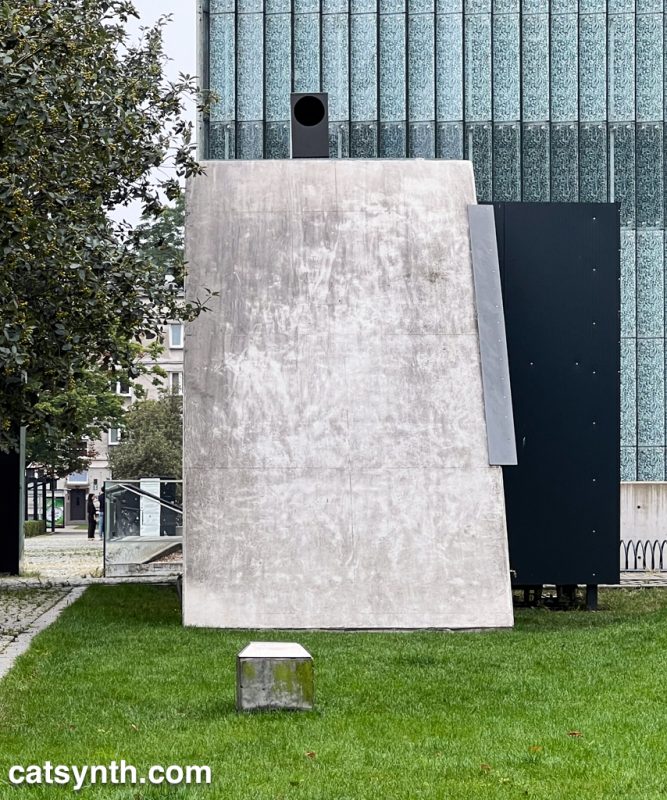
An interesting view of POLIN Museum of the History of the Polish Jews in Warsaw, featuring several different layers of geometry and texture.

Passover is, perhaps, the most “visible” Jewish holiday for me. After all, we have featured the Matzoh Man in many photos and short video clips here on CatSynth, and now twice in a row for CatSynth TV.
For this year’s episode, we took audio output from our mechanical friend via a contact mic and sent it into the KOMA Field Kit. We then split the signal into audio, which was run through our modular synthesizer – specifically, the Rossum Electro-music Morpheus – and the Field Kit’s own envelope follow and actuator section, ultimately driving the solenoid. It was a fun little demo both to make and to watch.
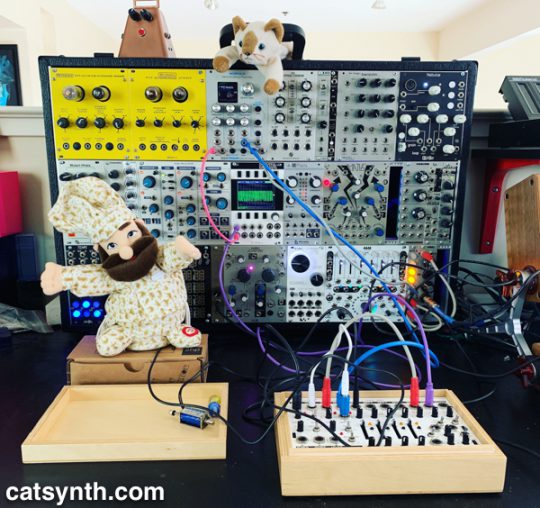
I also included a little demo of the ritual diet, with matzoh, prepared horseradish, and Kedem grape juice. But beyond that, anything is fair game for me during Passover as long as there are no piggies or shellfish, or leavened bread. No beer allowed, but non-kosher wine and spirits are fine. It becomes a bit of a game to see if for eight days I can follow these simple rules. To someone more Orthodox, or even the least bit devout, this simple approach could be transgressive, or even blasphemous. But from my point of view, not only is it plenty but I also sometimes wonder why I both at all. It’s not like I believe in the literal truth of the Biblical story, or have any fear of or respect for any religious authorities.
Somehow, though, I still feel compelled to participate. And not just participate, flaunt it, reminding friends that I can’t share pastries or bread products over the week because I’m Jewish. That feels important to remind people of. And it sometimes makes its way into my music, through titles like Kislev and Donershtik (Yiddish for Thursday) or organizing structures in stories. It’s fun. It’s “cool”. But also it feels more urgent, as the world around us seems more anti-Semitic now than it did during my youth. I’m deeply bothered by the attacks that seem to be increasing against Jews, both verbal and violent. But I’m also concerned with an increasing religiosity and sense of obedience among many who identify as Jewish. If being Jewish is just about being religious, or being obedient to a text or patriarchal authorities, then it does truly become time to ask “why bother?”. But for now, we do our best to both persevere and enjoy.
Chag Pesach Semeach.
Greetings, and L’Shana Tovah! Today we look back to a show from last weekend at The Chapel in San Francisco where two bands interpreted selections from John Zorn’s Masada songbook. It was part of a four-day residency by Zorn at the Chapel in celebration of his 65th Birthday.
“Masada” has morphed and grown as a musical concept since Zorn’s original Ornette-Coleman-inspired group from the 1990s. There have been follow-up projects, notably Electric Masada that we at CatSynth are most familiar with. But it is as much a songbook as a collection of ensembles. The “Masada songbook” contains hundreds of short compositions, sometimes just fragments, scales, or concepts. Originally intended to be performed by the ensembles, these compositions can be interpreted by other bands. And on this night, the bands took them in decidedly rock direction.
First up was Cleric. The Philadelphia-based “avant-metal” band currently features Matt Hollenberg on guitar, Nick Shellenberger on keyboards and vocals, Larry Kwartowitz on drums, and Daniel Ephraim Kennedy on bass.
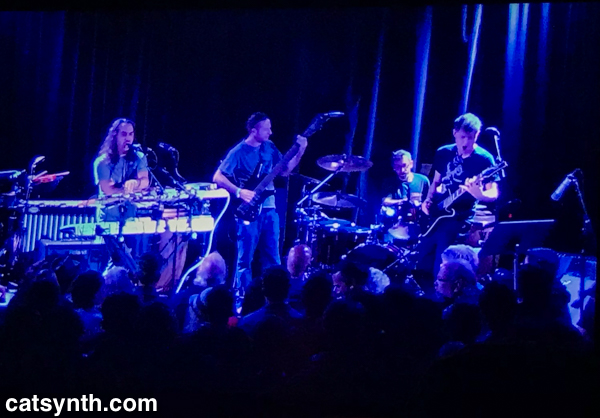
As their background implies, the performance was decidedly metal, a full-on triple-forte projection with growling vocals and fast runs punctuated by heavy drones. Nonetheless, it was top-notch musicianship and an adventurous choice of music. Within the mix, I found myself mostly focused on Shellenberger’s vocals and keyboards, though Kennedy’s six-string bass took center stage visually, and Hollenberg’s guitar performance added a solidifying aspect to the music. It was a solid set, and certainly an interpretation of the Masada songbook we have never heard before (and may never hear again).
Next up was Secret Chiefs 3, who brought a decidedly different sound and presentation to the stage.
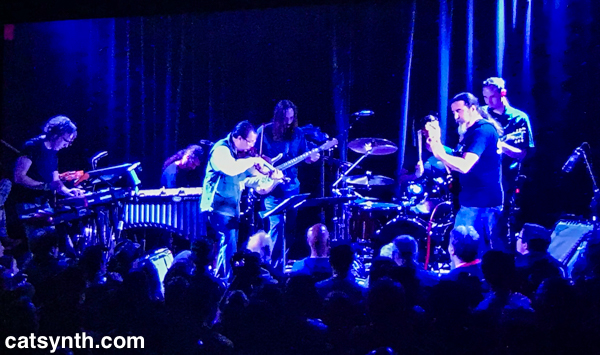
Led by guitarist and composer Trey Spruance (formerly of Mr. Bungle and Faith No More) and heavily featuring Eyvind Kang on violin, the group weaved together jazz, rock, folk, klezmer, and Middle Eastern influences into their eclectic set. Rounding out the group on this night were Jason Schimmel on guitar, Matt Lebofsky on keyboards, Shanir Blumenkranz on bass, Ches Smith on percussion, and Kenny Grohowski on drums.
It was an inspired and highly dynamic performance from these hometown favorites, and the band seemed a good match for the Masada songbook. There is an explicit thread of mysticism and the esoteric in both Zorn’s music and the work of SC3, so this is not surprising. I even recognized a couple of songs from Electric Masada recordings. The orchestration was brilliant and clever, bringing out each of the musicians as well as the Jewish influences of the songs. There were contrapuntal moments where the musicians played different lines and rhythms but coming together for short emphatic choruses with syncopated lines. It was crisp, tight, but also fun. And one could sense that the audience – a packed crowd on both levels of the Chapel, was having a great time along with them. The set was also the perfect length, keeping up the energy without petering out or overstating their welcome, leading to a single climax note that ended the music and cued Zorn and the musicians from Cleric back to the stage for a final group bow.
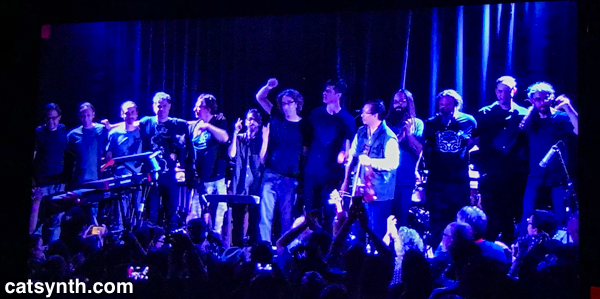
Overall, a fine night of music. As with many multi-day festivals, I regret not being there for the other nights, but glad I was able to make it to the one that I did. September is always the busiest month for music (and art) in San Francisco, and we will have much more to experience and share in the coming weeks.
Purim is the “most synthesizer-y” of Jewish holidays, given that one of it’s central rituals is noisemaking. This year we created a synthesizer demo running sounds from a gragger through several modules.
The demo uses a mixture of pre-recorded gragger on the QuBit Nebulae and live sound via the Mikrophonie and Make Noise Echophon. The full list of modules used in the Purim demo is:
I do wish I already had a Qu-bit Nebulae v2 for this project. You can see our review of v2 from NAMM 2018 here.
Purim is a holiday that commemorates the saving of the Jewish people in the ancient Persian Empire from the king’s wicked advisor Haman, as told in the book of Esther. Traditionally, the gragger is used to mask the name of Haman when said out loud during readings.

Fast, reflect, and question. These are our personal mandates on Yom Kippur this 5778 (2017). Fasting is pretty self-explanatory – I don’t do it every year, but this year it feels important to do so. Sam Sam does not have to fast. The questioning centers around “what does it mean to be Jewish in this time and place”, an especially complicated and treacherous question for those of us who are secular Jews. Yom Kippur is described in Leviticus, the one book of the Torah that I have not been able to get through in its entirety (mostly because it’s extremely dense and about as riveting as the phone book). But I still celebrate independent of that, based on heritage and family tradition. You are a Jew if your mother is a Jew, end of story. I extend this rule to my cats.

[Sam Sam is exempt from fasting]
For an excellent read on the topic of secular Jews on Yom Kippur, especially secular Jews committed to activism and social justice, please read this article by Dania Rajendra [Full disclosure: Dania is my sister-in-law.]. For me, part of my plan for this holiday was to compose a track based on sounds from a short-wave-radio synth module an, idea I formulated during a reflective moment last night.
[Cover image taken during Yom Kippur 2016, see this article.]
The track was recorded as a meditation of sorts, getting into a heightened, focused state while turning the knobs of the Eowave short-wave module, tuning into stations that aren’t there. The other “master” of the track was the Wiard/Richter Noisering, which I let control the Rossum Electro-Music Morpheus module. Both focus on chance and working with elements very much outside my control. I also did not want to spend much time outside the meditation-recording process itself. There is no editing save for some tapering at the beginning and end of the track and the obligatory EQ and compression.
I am both doing too much, and too little at the same time. I can’t save all the shelter cats; I can help everyone suffering through one disaster after another in North America and Carribean. But I can try to make a little bit of a difference in each. When I focus on all things “CatSynth”, sometimes my music suffers – I’m overdue booking new gigs for my band CDP and I do feel a need to atone for that. In short, the challenge in 5778 and beyond is to find a way of doing all the things that matter most while minimizing time and resources on the things that don’t. No easy task for someone who tends to say “yes” to everything, hates to disappoint others, and has a difficult time letting go of things. But that last one is another aspect of this holiday, and so it is as good a time to begin as any…
As we are in the middle of Passover, it seems like a good time to look back at a Jewish-themed show in which I participated earlier this year. The Amy X-Perience brought together a mix of artists in solo, duo and ensemble sets at the Jewish Community Center in Berkeley, California. The evening was curated by our friend and collaborator Amy X Neuburg.
The night began with a piece by Neuburg featuring electronics and potato chips. Yes, potato chips. Small vending-machine-sized bags were distributed to the audience, who were instructed to on cue open the bags and start chewing the (edible) contents loudly, as Neuburg manipulated the sounds and added additional musical layers.

I was up next. Regular readers have likely already heard part of my solo set from this show – I posted the performance of piece White Wine in this article a couple of weeks ago. I also performed a live version of my piece Donershtik (Yiddish for “Thursday”), which you can see below.
Amanda Chaudhary performing "Donershtik" at JCC East Bay from CatSynth on Vimeo.
I was quite happy with how both solo pieces came out, but the real treat was having Amy join me in a duo of my piece North Berkeley BART, humorously appropriate for the location that evening.
North Berkeley BART w/ Amy X Neuburg – JCC from CatSynth on Vimeo.
I have always been impressed with Amy’s musicianship, discipline and ability to learn songs quickly, and very much appreciated her joining me. We also performed an avant-garde rendition of the American standard All of Me later in the evening.

Between the two of us, there was quite an impressive collection of musical electronics on stage.
My solo set was followed by Alex Kelley, a veritable one-man band on cello and electronics.

His music blended jazz, klezmer and rock influences with experimental sounds. His cello acted not only as a melodic instrument, but also as the rhythm section, with Kelley striking it like a drum at times, and recording bass lines into a live looper and then riffing on top of that. His performance was both tight and humorous and a lot of fun to watch. You can hear a little bit in this video:
Next up was Solstice: A Female Vocal Ensemble. Sadly, several members of the group were unfortunately absent that evening due to illness, but that didn’t stop the remaining trio from delivering a strong performance.

Solstice’s repertoire spans a variety of styles and languages, and their set that evening included pieces from several places. I was quite impressed with their ability so sing in so many languages.
The second half of the program brought together the various artists in different combinations. I already mentioned my duo rendition of All of Me with Amy X Neuburg. She also performed show tunes with Alex Kelley, and joined Solstice for a virtuosic rendition of an Eastern European song. And finally, all of us joined together for a rousing rendition of Mein Herr from Cabaret. It was a fun and fitting conclusion to the evening.
All of the performances were well received by the enthusiastic full house. Thank you to Amy X Neuburg for inviting all of us to participate in this event, and to the Jewish Community Center of the East Bay for hosting! Please visit their website to find out about the many performances and other cultural programs hosted by the JCC.
In addition to fireworks, barbecues and the occasional embarrassing musical tribute, Independence Day is an opportunity to reflect on living in one of the world’s most unusual countries, even as it sometimes tries to pretend that it is a normal country. The latter comes out the imagery one sees today, with celebrations and streets lined with flags, and people and places that we try to think of as representative of the term “American”. Here I look some images and ideas from my personal and family history that are part of “American” that most readers, both in the U.S. and beyond, would not usually associate with the typical 4th of July.
You likely will not see the tenement buildings of New York’s Lower East Side, where half of my ancestors, Jews from Central and Eastern Europe (primarily Austria as well as Russia) settled at the beginning of the 20th century.

My mother’s family later settled in the central part of the Bronx – richly vital neighborhoods at the time that would later be synonymous with controversial building and demolition projects (think of the Cross Bronx Expressway) and still later with urban blight and decay.
It’s even less likely that you will see the countryside of Uttar Pradesh in India, with the other half of my ancestors came from.

My father from this part of India came to study in Minnesota, and numerous other relatives have settled in various towns and suburbs arounds the U.S over the years. Indeed, the equivalent image to the New York City tenement builds for the Indian side of my family might as well be the New Jersey Turnpike, another image you are unlikely to see in today’s celebrations, but is quintessentially American.

These are the states that I can think of immediately where relatives either currently reside or did so in the recent past:
New York
New Jersey
California
Maryland
Virginia
Georgia
Florida
Minnesota
Illinois
Wisconsin
Michigan
District of Columbia (Washington, DC)
Arizona
Texas
Indiana
Pennsylvania
Connecticut
Hawai’i
The Hawaii story is fun, actually. As it was related to me by a friend and former colleague who is from Hawai’i, he was playing with his band and a middle-aged man from New York approached them – ultimately, this led to his reciting his somewhat edgy poetry with their music in the background. It turns out that the poet is my cousin – our names are quite different, so there is no way my friend would have made the connection if I had not told him (the surprised reaction was priceless).
The family story is really a complex interplay not only of ancestral origins which get much of the attention, but of class, religious practice, geographical preferences, and the changes people experience even within a single lifetime. This complexity is another feature of American culture and history that is often hidden from our usual imagery – even the positive imagery that celebrates diversity, immigration and multiculturalism leaves out the complexity. And it is hard to think of life here without it – the idea of a homogeneous heritage in a single hometown with people who look and sound like each other seems…well, foreign.
So where does that leave things for me, now, in this story? Well, it’s complex as well. I find myself coming full circle to my Jewish ancestors in the Lower East Side – perhaps I may even live there sometime in the future. Some of my most experimental music pieces include instruments and idioms from Indian music. Some things have little to do with my ancestry, jazz which I have been returning to in the last year as a musical practice, the bits of East Asian culture I picked in both Asia and California, are all part of the mix. It’s not outside the realm of possibility that I might find myself in Hawai’i sometime doing improvised music and poetry. And like others, I am figuring out how to take all of these things make something of it in what seem to be rather challenging times. In the end, there is no conclusion, on the personal, family or national narratives – and it seems appropriate that way.